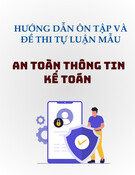
Cryptography

Contents
1) Basic Terminology of cryptography
2) History of cryptography
3) Symmetric Cipher
4) Asymmetric Cipher
5) Hashing algorithms

1. Basic Terminology

Basic Terminology
Plaintext: The original message
Ciphertext: the crypted message
Encryption: the process of converting plaintext into ciphertext
Decryption: the process of recovering ciphertext into plaintext
Cipher: is an algorithm to encrypt or decrypt information.
Plaintext Ciphertext
Ciphertext Plaintext

Basic Terminology
Cryptosystem: The algorithms, or ciphers, used to encrypt and decrypt
data
Cryptosystem = encryption + decryption algorithms.
Key: info used in cipher known only to sender/receiver
























![Sổ tay Kỹ năng nhận diện & phòng chống lừa đảo trực tuyến [Mới nhất]](https://cdn.tailieu.vn/images/document/thumbnail/2025/20251017/kimphuong1001/135x160/8271760665726.jpg)
![Cẩm nang An toàn trực tuyến [Mới nhất]](https://cdn.tailieu.vn/images/document/thumbnail/2025/20251017/kimphuong1001/135x160/8031760666413.jpg)
